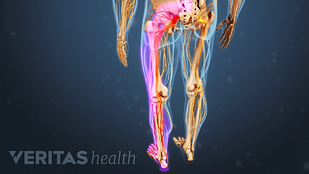In This Article:
Video Transcript
Foot drop is the inability to dorsiflex the foot, so, to pull the foot up. Foot drop often presents as people saying that they are tripping over themselves. Essentially, it’s hard to clear the foot, so people might, after they go for a long walk they might find that they start to trip over themselves. As the foot drop gets worse, then that can become more pronounced and more profound and often people will develop a steppage gait, which is basically you have to hike the leg up in order to clear the foot as you're walking.
Now, foot drop itself is not a disease, it's a sign of an underlying pathologic process. There are two general categories that we think of foot drop. The first is when people are plantarflex, so the calf is in spasm or it’s spastic and it’s not letting the muscles, the dorsiflexors, to overpower it, and so the dorsiflexor muscles can't bring the foot up.
另一个原因是缺乏神经和都应该是使足了肌肉之间的通信。现在,这种缺乏沟通的就是我们要重点关注的时刻和缺乏沟通可以在任何地方沿路径从大脑发生分解成足。因此,人们可以有核心问题,如在大脑中中风或肿瘤或帕金森氏,那么作为冲动归结脊髓你可以有脊髓病变。由于神经退出脊柱人能有所谓的“神经根病”,或更通俗神经压迫在后面。这当然会导致足下垂。然后那些神经脊柱出来,即进入背伸的那些,他们分支出来,他们走到一起,形成坐骨神经。而且,人们可以有坐骨神经的刺激。坐骨神经然后下山腿和分支机构再次进入腓总神经,而腓总神经还能够在其内的病变可引起足下垂。然后,你可以有神经肌肉接头处的问题,以及和肌肉本身。所有这些事情会导致足下垂。
When the problem is coming from the spine, typically will be an L5 radiculopathy, irritation around the L5 nerve. And that irritation it comes, in general, from the same kinds of things that can also cause pain going down into the leg, which are things like herniated discs, spondylolisthesis, facet joint arthropathy, spinal stenosis, essentially narrowing of the space where the nerves exit the spine, which can then put pressure or irritation around that nerve and then leads to a lack of communication between that nerve and the muscles that are supposed to do the job of lifting up the foot.
Often, but not always, there'll be an accompaniment of pain, numbness, tingling, but sometimes it can just present as foot drop in the absence of other symptoms.






